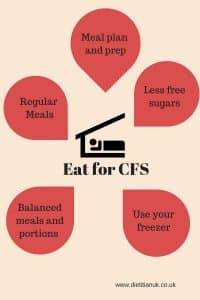Chronic Fatigue Syndrome (CFS) or Myalgic Encephalomyelitis (M.E.) is one of those areas that I didn’t ever set out to work in. It just came along and found me. An Occupational Therapist who I had worked with previously approached me and asked if I would be interested in joining their team. With every bit of work I take on I have to ask myself – is my heart in this. If the answer if No then I don’t accept it. Now my heart was very much in this, as years previously, as a teenager, my mum suffered from CFS. She went from being a very bubbly, energetic, full of life person, to someone who had to rest 95% of the time. Thankfully, she recovered and now lives life almost to the same capacity as before, perhaps with a bit more caution! So, working with this client group holds a special interest for me.
I work with South Coast Fatigue and Associates, a team who are full of care, in fact the most caring bunch I’ve worked with. Plus we have the most amazing Christmas meal ever! I don’t get to hang out in the office often but I feel very privilieged to be part of the team and to be trusted to give advice to the clients. This is a very vulnerable area, some people are literally bed-bound, others are able to do small day to day activities but there is a lot of loss, resting and frustration around. Everyone wants a magic fix and the internet abounds with diets that will cure, magic supplements and herbal remedies. This is where I come in.
I work on a 1-2-1 basis with people giving advice on IBS, healthy eating, weight loss, weight gain, special diets – whatever is needed. I also run a monthly nutrition group, which is usually a very interesting couple of hours due to all the questions people bring. So here are my top 5 tips on eating well for energy.
1. Eat regularly. Skipping meals is not a good idea. The body needs a energy to heal and to function. I completely understand that the nature of CFS means that sometimes people are too tired to prepare a meal, so this is where the planning comes in. Having instantly accessible healthy snacks that can be grabbed.
2. Focus on the balance and the portion control. I encourage people to fill their plates with 1/2 vegetables and then 1/4 lean protein and 1/4 wholegrains or starchy foods. If you are less active than before, then portions will need to reduce. This can be a tricky to work out, so I do sometimes recommend a portion plate.
3. Plan, plan and plan. Build up a folder of meals, recipes and snacks. Some that are fast to make (beans on toast, ready meals, tinned soup and a roll, hummus and pitta, peanut butter and rice cakes), some that take more preparation (jacket potatoes, fish cooked in a parcel, stir fry, pasta dishes) and some you can get help to bulk cook (slow cooker meals, bolognaise, fish pie). Then do an online shop and stock up the cupboards with easy meals.
4. Use the freezer. Frozen veggies and fruit are very nutritious and quick to use. They save peeling and chopping, which saves you energy and time. There is now so much variety in frozen vegetables, it isn’t all peas and sweetcorn. Bulk cooking meals and freezing them is also so useful so there is a stash of good food for days you need it.
5. Step away from the sugar. Although you may feel like you need a sugary boost to keep your energy levels high, that can lead to a sugar peak and crash effect. Instead fuel your body with low glycaemic index foods that will provide sustained energy over the day. Foods like oats, wholegrain bread, bulghar wheat, yoghurt, hummus, apples and nuts.
See this link here for a fact sheet and here for a table of the Glyacemic Index of Foods.
